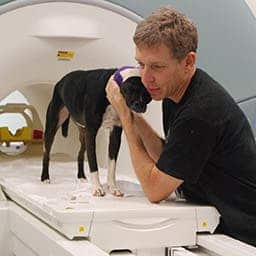Most dog owners will tell you that their pets are awesome. They love their dogs, and their dogs seem to love them back. But do dogs genuinely feel love or any kind of positive emotion similar to how a human does for that matter? This is a question that has eluded scientists for a long time.
It’s easy to put a dog’s tremendous enthusiasm whenever their owner comes home as just as a form of attachment, viewing the human as a walking, breathing food dispenser and nothing more.
But a breakthrough research might change the way people view dogs forever. According to neuroscientist Gregory Berns, “dogs are people, too.”
He reached this conclusion after performing MRI scans on over a dozen dogs, finding the same brain region responsible for positive emotions in humans is activated in dogs as well.
[Also Read: Do dogs dream?]
To infer animal sentience and other neurological traits, scientists rely on animal behaviorism. You can’t ask a dog how it feels, or what it’s thinking. As such, it’s been considered an extremely challenging area of research. By using brain scans, however, one can bypass having to directly ‘speak’ to an animal. Instead, you let the brain do all the talking.
But this doesn’t mean performing MRI on animals is straightforward. The machines are racketing, claustrophobic, and generally unpleasant even for humans. For them to work you have to stay completely still. You can imagine how difficult it is to get a hyper labrador to stay put while all kinds of machinery are diverting its attention. Typically, veterinarians perform anesthesia on dogs whose brain scans they need to perform, but this renders any kind of emotion monitoring useless.
Dog emotions, not too different from ours
https://www.youtube.com/watch?v=YiTQHZZ459A
Berns tackled this issue by training dogs using painstaking reward exercises to stay still when inside the operating MRI, and in doing so he has performed the first wake dog MRIs, as reported in PLOS ONE. Inside the scanner, the dogs’ brain activity was measured for a two-hand signal (which they learned to associate with food), as well as for scents of familiar and unfamiliar dogs and humans.
Both the human and dog brains are strikingly similar in function and structure in one key region: the caudate nucleus. Located between the brainstem and the cortex, the dopamine-rich caudate plays a key role in the anticipation of things we enjoy, like food, love, and money — things that are associated with positive emotions.
“Many of the same things that activate the human caudate [part of the brain], which are associated with positive emotions, also activate the dog caudate. Neuroscientists call this a functional homology, and it may be an indication of canine emotions,” Berns wrote in an article for the NY Times.
In response to hand signals indicating food, as well as smells of familiar humans, the canine caudate activity increased. And in preliminary tests, it activated to the return of an owner who had momentarily stepped out of view. Neuroscientists call this a functional homology, and it may be an indication of canine emotions.
“The ability to experience positive emotions, like love and attachment, would mean that dogs have a level of sentience comparable to that of a human child. And this ability suggests a rethinking of how we treat dogs,” Berns said.
“DOGS have long been considered property. Though the Animal Welfare Act of 1966 and state laws raised the bar for the treatment of animals, they solidified the view that animals are things — objects that can be disposed of as long as reasonable care is taken to minimize their suffering.”
“But now, by using the M.R.I. to push away the limitations of behaviorism, we can no longer hide from the evidence. Dogs, and probably many other animals (especially our closest primate relatives), seem to have emotions just like us. And this means we must reconsider their treatment as property.”
So, do dogs truly love us? We can’t be sure, but next time you see your dog wag his tail you can be sure he’s happy, scientific proof included.
[NOW READ] Study proves humans can read a dog’s emotions just by looking at its face
Gregory Berns is a professor of neuroeconomics at Emory University and the author of “How Dogs Love Us: A Neuroscientist and His Adopted Dog Decode the Canine Brain.”











